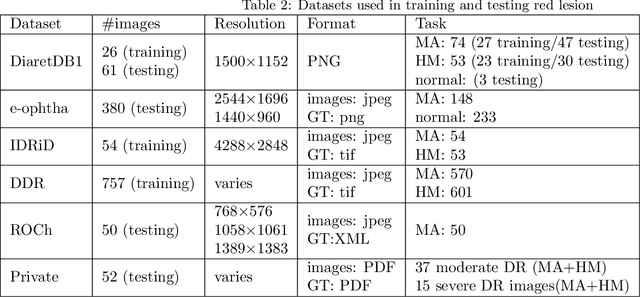Norah Asiri
A Deep Learning-Based Unified Framework for Red Lesions Detection on Retinal Fundus Images
Sep 17, 2021



Abstract:Red-lesions, i.e., microaneurysms (MAs) and hemorrhages (HMs), are the early signs of diabetic retinopathy (DR). The automatic detection of MAs and HMs on retinal fundus images is a challenging task. Most of the existing methods detect either only MAs or only HMs because of the difference in their texture, sizes, and morphology. Though some methods detect both MAs and HMs, they suffer from the curse of dimensionality of shape and colors features and fail to detect all shape variations of HMs such as flame-shaped HM. Leveraging the progress in deep learning, we proposed a two-stream red lesions detection system dealing simultaneously with small and large red lesions. For this system, we introduced a new ROIs candidates generation method for large red lesions fundus images; it is based on blood vessel segmentation and morphological operations, and reduces the computational complexity, and enhances the detection accuracy by generating a small number of potential candidates. For detection, we adapted the Faster RCNN framework with two streams. We used pre-trained VGGNet as a bone model and carried out several extensive experiments to tune it for vessels segmentation and candidates generation, and finally learning the appropriate mapping, which yields better detection of the red lesions comparing with the state-of-the-art methods. The experimental results validated the effectiveness of the system in the detection of both MAs and HMs; the method yields higher performance for per lesion detection according to sensitivity under 4 FPIs on DiaretDB1-MA and DiaretDB1-HM datasets, and 1 FPI on e-ophtha and ROCh datasets than the state of the art methods w.r.t. various evaluation metrics. For DR screening, the system outperforms other methods on DiaretDB1-MA, DiaretDB1-HM, and e-ophtha datasets.
Deep Learning based Computer-Aided Diagnosis Systems for Diabetic Retinopathy: A Survey
Nov 03, 2018



Abstract:The outstanding performance of deep learning in various computer vision tasks motivated its application for medical image analysis, in particular, retinal fundus image analysis. It has been applied to a variety of tasks including diagnosis, detection and segmentation of pathologies in retinal fundus images. Many deep learning based techniques have been proposed to analyze retinal fundus images for automatic detection and diagnosis of macular degeneration and diabetic retinopathy. The automatic detection of diabetic retinopathy has the potential to prevent cases of vision loss and blindness by boosting the examination of diabetic patients. We carried out a comprehensive study of the latest deep learning techniques and their use in fundus image analysis. This paper presents the key concepts of deep learning relevant to diabetic retinopathy images analysis and reviews the latest deep learning based contributions in this area. We conclude the paper with a summary of the state-of-the-art, a critical discussion of open challenges and directions for future research.
 Add to Chrome
Add to Chrome Add to Firefox
Add to Firefox Add to Edge
Add to Edge